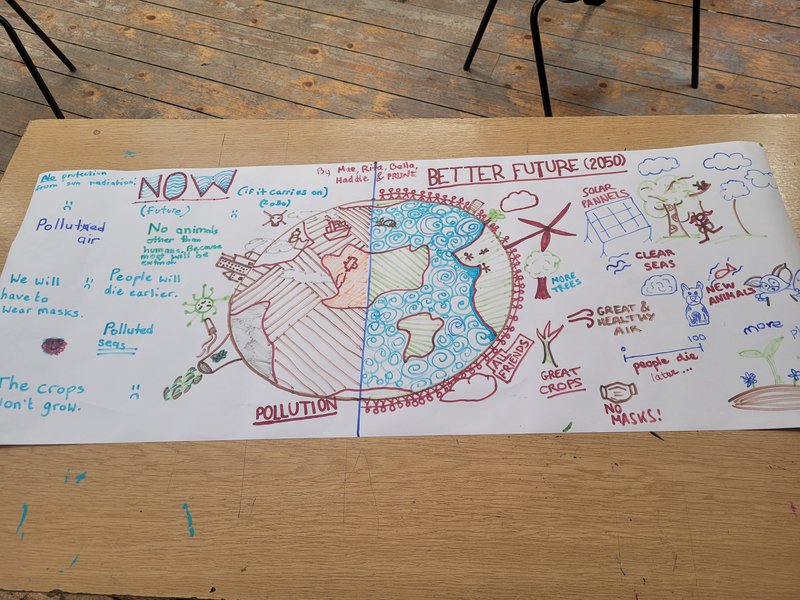Co-creating positive visions for a sustainable future
CAT worked with partners to co create workshop activities involving voices drawn from a young, diverse urban, audience. The aim was to develop agency and positive visions for the future.
C.A.T
Who did you work with?
Montgomeryshire Wildlife Trust (MWT)
Had you worked together before?
The Centre for Alternative Technology (CAT) had prior experience of working with both Civic Square and Bright Green Futures having hosted groups from the organisations on site and through the delivery of engagement activities. In the case of Civic Square, it was through participation in the work of CAT’s Zero Carbon Britain (ZCB) Hub. CAT had not worked directly with the Wildlife Trust before, but the organisations were familiar with each other through event participation and though staff networking.
What priorities did you identify with your partner and how did this project meet the longer-term priorities of everyone involved?
CAT was looking to engage with partners, to enable the co creation of workshop type activities involving voices drawn from a young, diverse, and urban audience in contrast to CAT perceived rural context. Our key partner in this was Civic Square and together we identified that the priority was to understand how our model of future visioning supported by practical activities would translate to an urban, multi-generational audience. Developing agency and positive visions for the future was a theme that united the work of all the partners however and was further explored with Bright Green Futures and the Montgomeryshire Wildlife Trust.
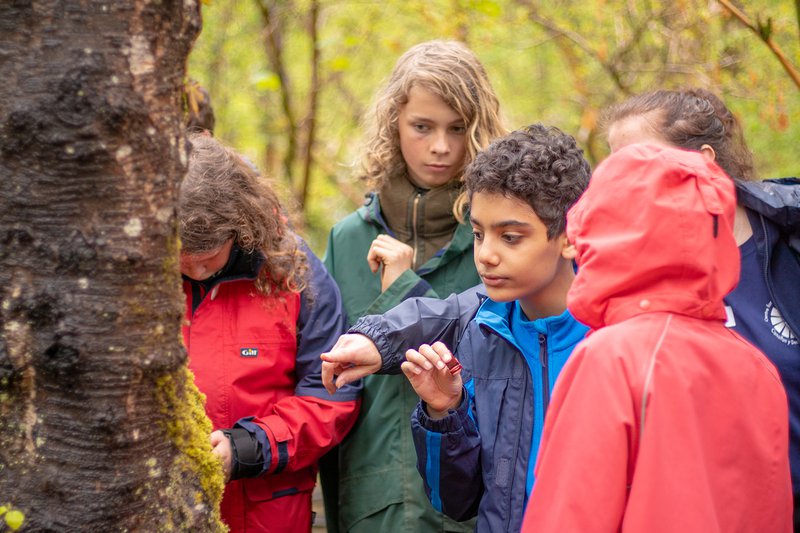
Can you summarise the aims of your project delivery?
The goal of CAT’s project was to build on the organisations experience in successfully delivering zero carbon future visioning training for councils, communities, and organisations to develop experiences and learning opportunities that would help CAT deliver its vision and mission to new audiences, enabling them to imagine positive visions for the future.
The concept of the visioning is to first look at the current situation with the climate and policy context to ensure that everyone has the baseline understanding of the problems that we need to address together. Participants then explore ideas about the future they would like to see and then the barriers that stand in the way of their vision. Interventions or possible solutions are then identified and rated for their potential impact, participants are then able to identify effective actions that they can take relevant to their own context and any skills or training they would need. Skilled and effective facilitation is key to this process.
The aim was to achieve this by co-creating and piloting a range of facilitated and self-led visioning experiences for visitors and learners by bringing together young and underrepresented groups to work with CAT’s site engagement and Zero Carbon Britain Hub teams whilst also using the opportunity to build capacity within those same teams.
How co-produced was your programme?
Deciding together (encourages new and additional options, and joint decision making)
What steps did you take with your community partner in order to reach this level of co-production?
Having previously worked with both Civic Square and Bright Green Futures on visit and engagement programming, there was already a level of trust between our organisations. The relationship with Montgomeryshire Wildlife
Trust was via a member of our team who had previously worked as part of their engagement team.
The initial step with the partners were meetings with their senior teams, to talk through the scope of the funding, our ambition for the project and the potential fit with their organisational missions.
Joint development session then took place to look at the content and cocreate the structure and programming of the pilot visioning workshop programme.
Working with the participants, ideas, thoughts and concerns were shared and gathered on the process and sessions. For ease of access, the CS and BGF sessions were held online in the evening. For the MWT we were able to attend one of their regular eco group sessions in person and this also gave us an opportunity to talk to some of their parents at the same time.
Following on from these partner sessions, draft programmes for the visits were produced for consultation, a process which helped ensured all the voices of those who had participated felt satisfied they could see their thoughts reflected in the final programmes.
The final programme included an initial presentation and discussion about the climate and biodiversity emergency, themed practical activities and informal conversations working with the ranger team and then a visioning workshop where participants worked collaboratively to create rich graphics and text describing the future they imagined.
The workshops helped us connect to our core values - time in nature to connect to our core values. Hearing different opinions across the age ranges. - Participant
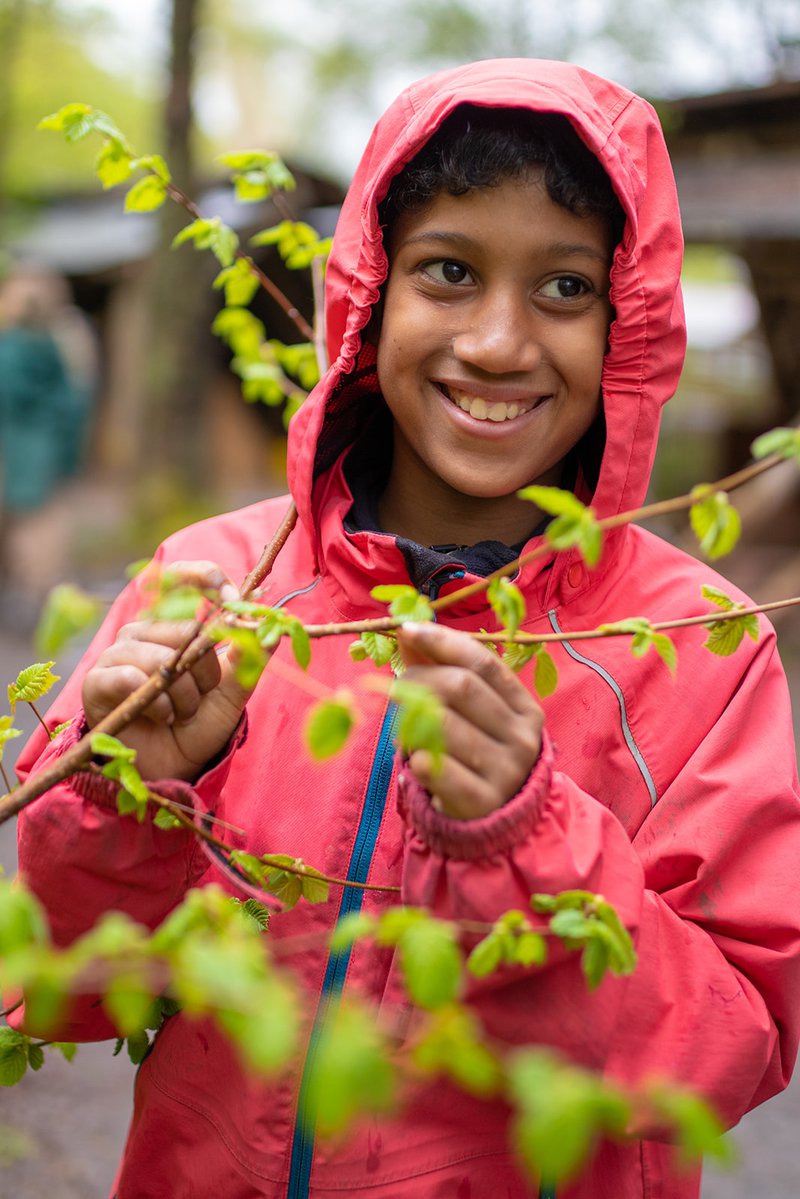
Can you note down some of the benefits and challenges to working this way?
A key benefit was to engage with voices that were very different from our existing partners, particularly the urban perspective on approaches to and the challenge of, the climate and biodiversity emergencies.
Working with people from very different lived experiences and perceptions was vital in helping us identify the needs, interests and relevant skills that the communities they represented were likely feel they needed to engaging with and address with relevance to the climate emergency.
Equally at a very practical level, we needed to know how the delivery and activities we ran on site could be adapted to work best in meeting these needs. This was vital to the success of the programme and also in developing the thinking as CAT works to develop the future direction and nature of its visitor centre operation.
Early in the co-creation process it became clear that to ensure community participation, the groups coming to site would be multi-generational. This was perhaps our greatest challenge especially as it was far removed from our site teams experience and the level support required whilst they were on site.
What was the STEM link?
Through the medium of discussion and practical activities delivered on site at CAT by the ranger team (engagement), participants were engaged with knowledge and skills around:
- Climate change
- Biodiversity
- Diets and horticulture
- Composting and soils
- Sustainable building materials and construction
- Renewable Energy
What happened?
The essence of what we wanted to achieve was to take our Zero Carbon Britain future visioning workshop, that had worked so successfully through 2021 and 2022 and been so well received by councils, communities, businesses and other organisations and adapt this approach for use with our broader site audience. This meant developing the concept to become part of our education offer for visiting educational groups and as part of our visitor centre programme.
The context for this was the continuing recovery of the site operation following the pandemic and a major master planning project exploring the future of the CAT’s site and its role in the delivery of the charities vision and mission. For both, it was clear CAT need to reach out to new, more diverse audiences to expand its reach.
What we didn’t know or understand at the outset was how well the concept would transfer and work in practice, especially as most of the visioning workshops we had delivered to date were to online audiences.
Our partners in the project played an essential role in enabling the audience contact:
a. Civic Square – multi generational, diverse urban audience
b. Bright Green Future – young urban audience drawing on their programme alumni from across Britain.
c. Montgomeryshire Wildlife Trust Youth Action Group - providing young people with a sense of ownership & agency through developing positive solutions for the future of the planet – climate & biodiversity.
We had originally hoped to include our local secondary school as a project partner, but unfortunately our link member of staff left at the end of the spring term. Given our local geography and the timeframe we were working too, we quickly linked with the MWT eco group, who represented two local schools (Tywyn High School and Bro Hyddgen, Machynlleth) as well as home schooled children.
Civic Square came to site in April and the key learning was that participants in the visioning exercise needed more time to reflect and imagine, immersed in the positive, stimulating environment of the CAT site. It was therefore clear that the activity programmes need to allow space for this. We have continued to work with CS and are now working with them on a skills-based programme, a neighbourhood trade
school, supporting the knowledge, skills and confidence for neighbourhood action and resilience.
Bright Green Futures provided our second cohort, coming to the CAT site in May, by which time we had amended the programme following the feedback from CS to allow more reflection time. The alumni were drawn from across Britain and had not met each other before, so we needed to bring the group together at the outset. The feedback was that the experience was empowering with participants feeling more positive about the challenge presented by the climate and biodiversity emergency, that there are solutions and that they have a part to play. The casual conversations during the workshop activities were referenced as particularly valuable. One of the changes we made to the programme for this group was that added some nature connection and mindfulness activities to help with the imagination and exploration of these biodiversity theme.
The young participants who joined us through the Montgomeryshire Wildlife Trust in April really embraced the challenge and were able to connect with the young people from Civic Square and work together sharing their contrasting urban and rural lived experiences. Again, the experience was empowering and gave hope for solutions. MWT are local to us and would like to continue to work with CAT as we develop our activities, following this project. Interestingly the MWT parents who stayed with the group, also reported feeling empowered and gathered new ideas.
CAT has a significant university group audience and during April 2023 we were able to take the opportunity to trial the visioning theme with a new residential field trip booking from Leeds University’s geography department. We were able to successfully adapt the visioning delivery model for them by splitting the groups and assigning thematic sustainable ‘missions’ for them to explore through the same model of ranger led activities and visioning workshops focused on the university and the city of Leeds. In this case the workshops were facilitated by the Leeds staff after discussion with our team. The result was a very lively two-day visit rounded out by group presentations and Leeds have already booked again for 2024.
Equally we didn’t know what the potential impact could be when our visitors or education groups return to their home environment. The feedback about the experience was overwhelming positive as well as developmental to help us to adapt these activities for urban environments. The activities themselves provided a vehicle for the important conversations around climate and community resilience.
The final piece as part of this project was a Bold Futures workshop as part of our 50th birthday celebration event in August, which was attended by 750 people. Here the workshop was a ‘drop in’ and so less structured. Participants were able to imagine a positive future and talk about the tools they would need, but there were important differences to note between this and the longer activities we had previously run. The experience time was shorter and therefore additional opportunities were needed for participant to access curated research and information. To enable this in the future without destroying the conversational dynamic we intend to use tablets and with a thematic menu of ides and case studies.
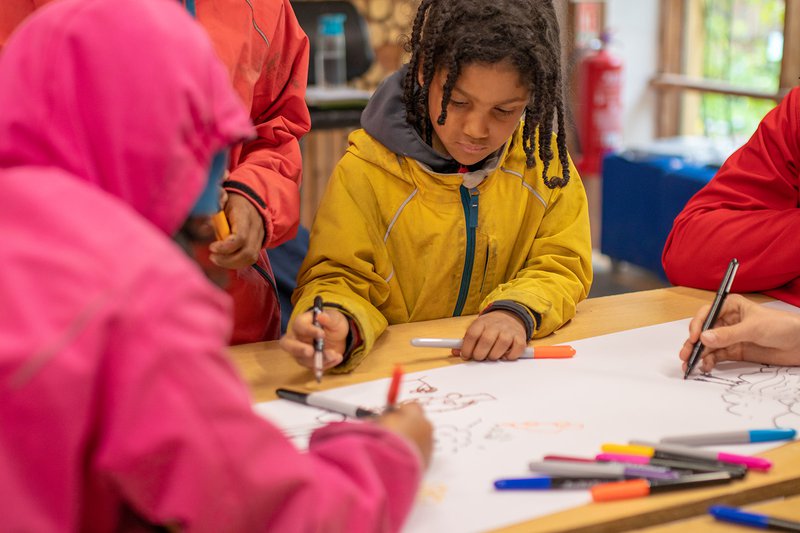
‘I had a brilliant time and am now much more positive about the future - and optimistic that we can all make effective change to help solve the climate crisis'
What challenges might lie in wait for someone wanting to replicate this project
One of the big challenges for us was offering a programme that included as many opportunities as possible without being overwhelming. Following feedback from the earlier workshops, we reduced the number of activities on the programme and included time for participants to reflect and embed the learning.
Gathering impactful feedback proved challenging, participants talked about how much they enjoyed activities and the experience, drawing out what impact it might have for them and their communities was more challenging.
Early in the co-creation process it became clear that to ensure community participation, the groups coming to site would be multi-generational. This was perhaps our greatest challenge especially and it was far removed from our site teams experience.
Were there any surprises?
Supporting changing views of what is required from the capital development based on …. We also learned how people access an activity like this and the kind of resources and support that will be needed. The facilitation needs to be very light touch so that it does not guide or lead the outcome.
There is a real danger of the ‘facilitator effect’, as groups quickly latch onto what they think the facilitator wants them to say. More training and experience is required before the participants begin to explore their vision for the future, with ongoing engagement needed.
How did you capture/measure the impact for this project?
We used an online form and feedback link initially, but this was another key learning – many participants either did not have digital access and/or skills to return feedback in this way, or just did not have the time to submit this. We found a post visit meeting with comments captured during the discussion worked much better and also provided paper feedback forms for completion during the visit for later groups. Jam board was an effective tool used to record the feedback.
Feedback was analysed and has been invaluable as we develop this workshop/visitor centre activity.
Where is the long-lasting change?
For CAT, legacy of this project has been:
- Creation of a new workshop and programme model for use with our educational visitors
- A workable protype ‘drop-in activity’ to use within our visitor centre programme.
- An updated Zero Carbon Britain trail for use by visitors and groups, providing up to date information and inspiration for behaviour change.
- New IT resources for use in the workshops and equipment to better enable our rangers to engage broader audiences with the practical activities they use to link to broader sustainability themes.
More broadly the project has contributed to the production of a new engagement strategy for CAT which itself plays into our own ‘visioning’ as we work on plans for a major redevelopment of our site and the experience it provides for visitors and learners.
Finally, our partner relationships have continued to develop with for example further work with CS as part of their Neighbourhood Trade School project.
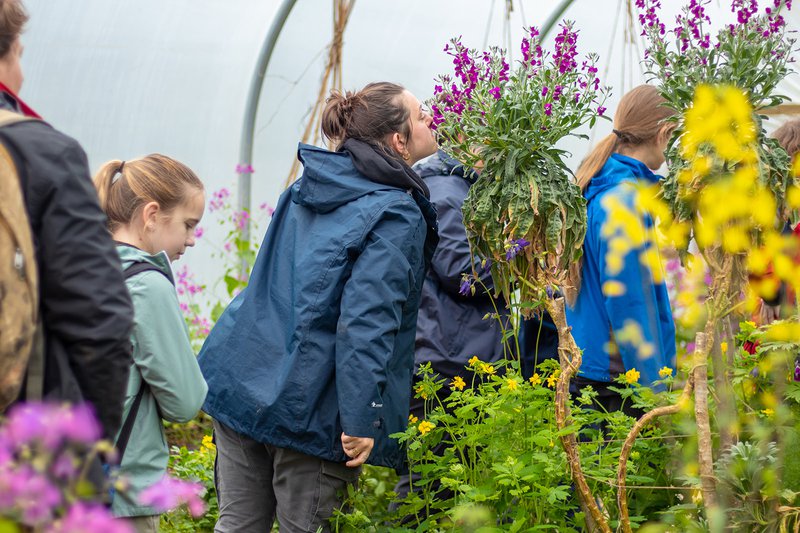
Did this project impact the future sustainability of your organisation?
The opportunity provided by Bold Futures was incredibly timely for CAT given our development plans which are essential the future sustainability of the organisation. More immediately, the insight, research, development and resources the project has enabled have provided a new context for our visitor and learner programmes which will head up our programme for 2024.
